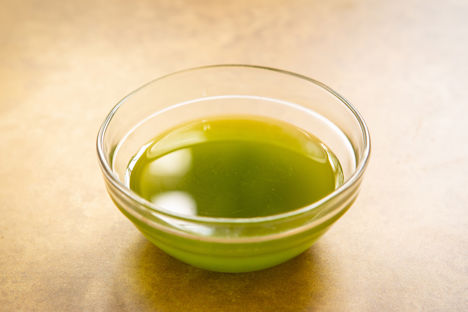Herb oils are now a regular addition to pretty plates at top restaurants, as chefs use them to split sauces or add pops of bright green colour and, of course, flavour to dishes. They can be stored in squeezy bottles in the fridge and are a handy ingredient to have on hand for finishing touches. Follow our guide to making vibrant green herb oils, find out how easy they are to make, and see the difference they can make to your home cooking.
Which herbs can I use to make herb oil?
Use any soft herbs to make herb oil, for example basil, chives, parsley, coriander or chervil. You can also use a mixture of herbs for a more general-use oil, or use other soft, flavoursome leaves such as wild garlic or lovage.
How do you make herb oil?
Making herb oil involves a few stages, but they’re all simple to follow. The various methods outlined below all perform a function to ensure you end up with a clear oil with a bright green colour.
The more oil you use to make your herb oil the more you are - obviously - diluting the herb flavour. So, you can make a very strong oil with a 50:50 herb-to-oil ratio, or you can maximise the amount of oil by using twice as much oil as herbs. We like to use one and a half times the amount of oil to herbs, as we think it ensures the best flavour to value for money ratio.
Herb oil
Metric
Imperial
- 200g of soft herbs
- 300g of groundnut oil
- a coffee filter, for straining
Blanch the herbs in boiling water for 30 seconds, then immediately refresh in a bowl of iced water. Blanching destroys the enzyme that causes the herbs to oxidise and turn brown, ensuring the herb oil has a bright green colour
Squeeze the herbs to get rid of any excess moisture, then spread the herbs out to dry on a clean cloth, patting them as dry as you can
Place the herbs and oil into a blender and blend until the outside of the blender feels hot
Transfer the herb oil to a small bowl, then place in a larger bowl of iced water, to chill it down quickly. This will also help to keep the herb oil a nice bright green colour
Transfer the oil into a coffee filter suspended over a container and leave to strain overnight
Store the herb oil in the fridge for up to 2 weeks
Why isn’t my herb oil bright green?
There are a few points to remember when making herb oil, which will help ensure perfect results every time. Firstly, it’s essential to use fresh herbs - any wilted herbs will add a dull brown colour to the final product.
It’s also important to blanch the herbs before blending - blanching destroys the enzyme that causes the herbs to oxidise and turn brown, ensuring the herb oil has a bright green colour.
Finally, using a high powered blender will ensure that all the colour is extracted from the herbs as they’re blended. Chilling the herb oil down quickly over a bowl of ice is also very important.
Why is my herb oil bitter?
Straining the herb oil slowly overnight will extract all the herb flavour without any bitterness. Pressing down on the herbs to extract the oil will release too many unwanted flavour compounds - the process can’t be rushed!
What can I use herb oil for?
Use herb oil as a garnish for a pale sauce with a contrasting colour, or add dots to a soup for a pretty, glass drop effect. It can also be used in place of regular oil to make a bright green mayonnaise, or drizzled over salads in place of olive oil. Try drizzling a basil oil over a homemade pizza, or use it to garnish canapés or bruschetta.
Get in touch
Please sign in or register to send a comment to Great British Chefs.


